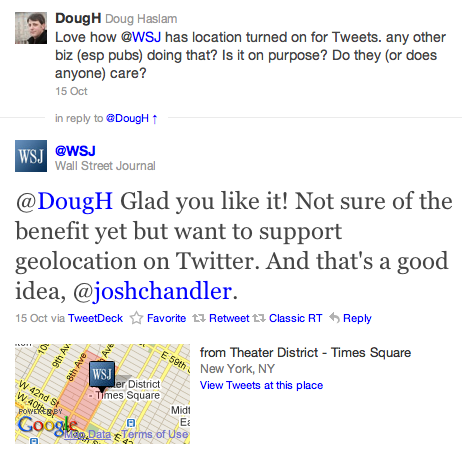I noticed in a Wall Street Journal Tweet that they included location, which of course was the WSJ headquarters. My reaction? That it further legitimized the Tweet, showing that it emanated from the real HQ, not some random place. As you can see in the exchange below, another Twitterer, Josh Chandler, suggested that reporters could turn on location from where they send Tweets as well (a little map showing a reporter is actually in Kabul – or wherever – adds a whole new flavor of authenticity, doesn’t it?).
I guess you’ll never know where geo-location will actually stumble on to a practical use. sometimes it’s just the little things.
Josh Chandler’s Input:
[blackbirdpie id=”27443728208″]


Twitter Comment
Doug Haslam » Blog Archive » A Side Effect of Using Location in Tweets; Credibility [link to post]
– Posted using Chat Catcher
Pretty easy to fake location, though.
True, but I was thinking more that it hadn’t occurred to WSJ (or likely others) that including location (on your legitimate posts) does have a positive effect on the reader (this reader at least). Small, but nice, side effect.
Doug,
Thanks for featuring my thoughts about @WSJ and location on your blog post.
Honestly, if we are transitioning to citizen journalism, why can’t WSJ build a dedicated map on their website which features reporters with their associated location and tweets about the event.
Twitter did it at SXSW this year and it worked very well!